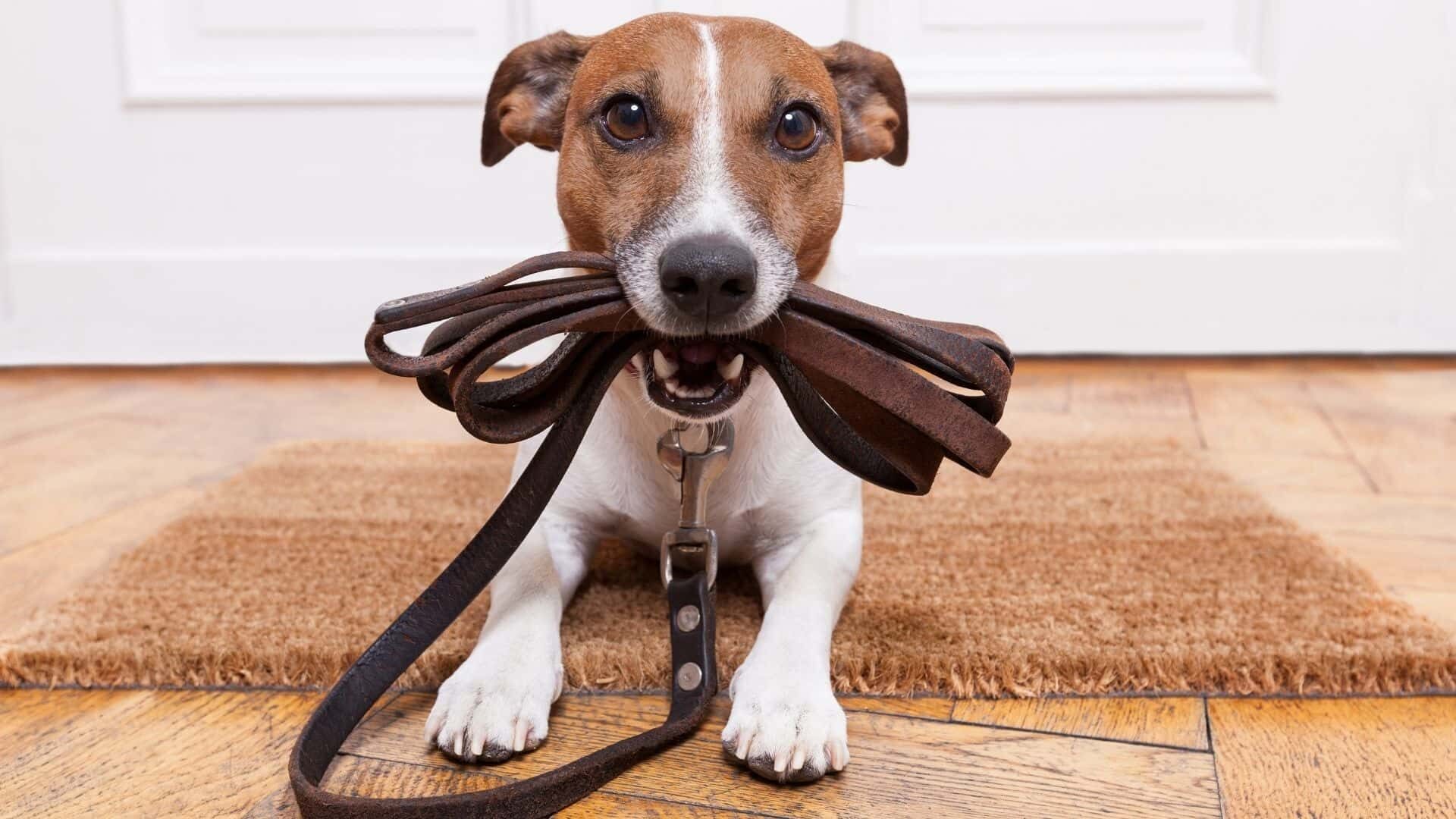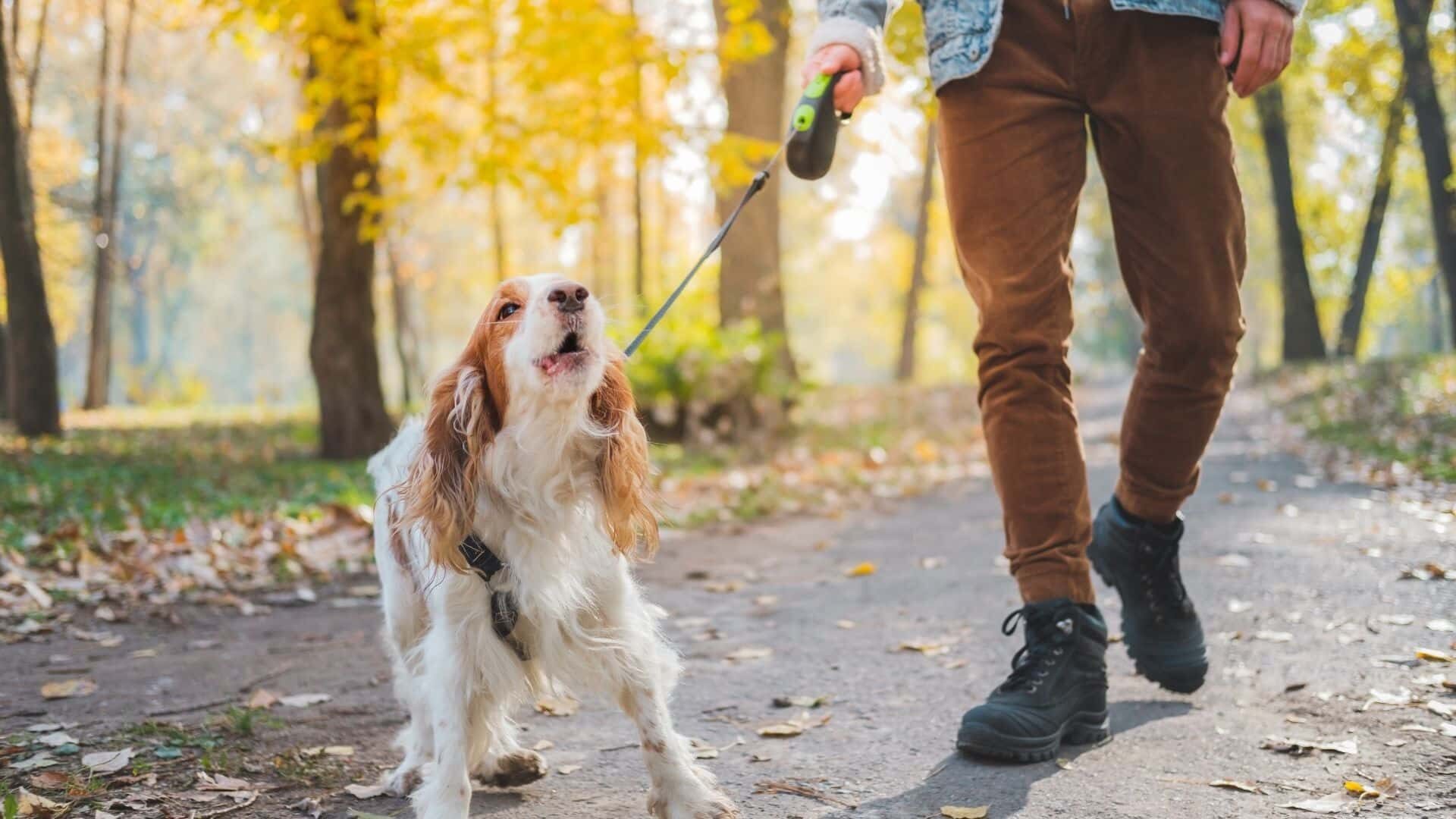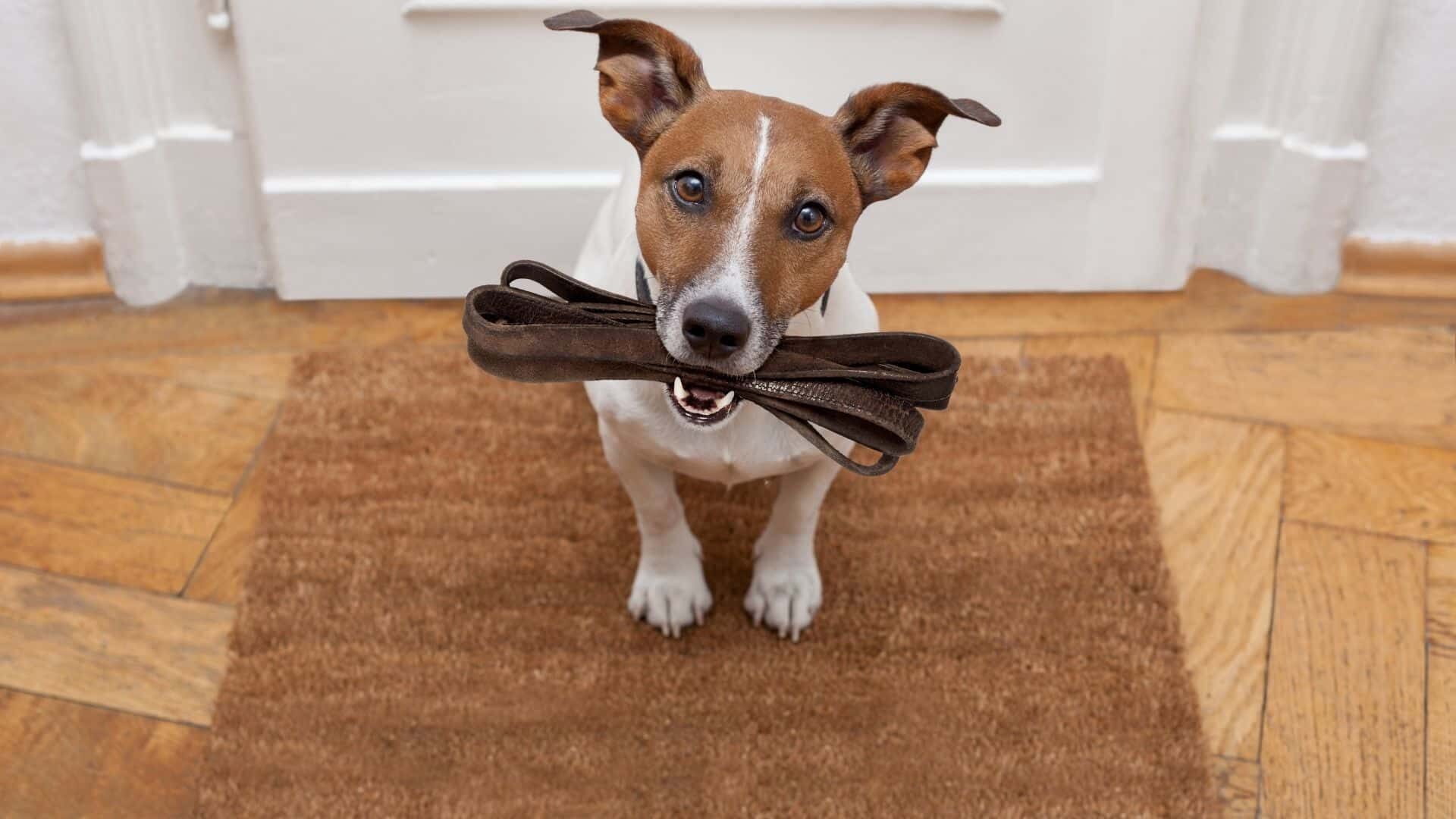Walking will help maintain your dog active and in a healthy weight range, as well as address their behavioral demands, such as the need to socialize with other dogs, daily. We also know that dog walking provides similar advantages to owners and is a delightful way to deepen our special bond with our four-legged companions.
Starting off on the right foot by effectively training your dog to walk on a leash will ensure that walking your dog is a happy experience.Training your dog to walk on a leash, also known as loose lead walking, entails teaching your dog to walk behind you.
This is a fantastic exercise to undertake to ensure that your walks with your dog are both safe and fun. It also encourages your dog to pay attention to you. Indoors, away from other distractions, is the best place to begin loose lead training. The suggestions that follow will assist dog owners in training their pets to walk on a leash.
How to train a dog to be on a leash?

1. Choose the correct walking equipment
There is a lot to consider when deciding what equipment is best for your dog, from collars and harnesses to leads. All dogs are required by law to wear a collar and identification tag, and a flat collar is ideal for this.
Collars and harnesses that tighten as your dog pulls are not suggested since they can cause your dog discomfort. If your dog is very strong, a harness with a front and back ring may be the most effective, since these allow you to exert more control over your dog’s chest, particularly when combined with a double clip lead.
On larger dogs, head collars can be utilized, but they must be introduced gradually and pleasantly. To educate your dog to walk on a loose lead, use three-to-four-foot leads (training leads). This training does not allow for retractable leads, slip leads, or long lines.
When the dog pulls, some equipment creates pain or discomfort by putting tension in a sensitive location. This is unnecessary, and it can make them feel uncomfortable and confused.
Take your dog for a walk with whichever equipment suits them best (such as a flat harness or collar). If utilizing a harness, introduce it in a gentle, pleasant way.
2. Training your dog to walk with the lead
In your left hand, hold the lead, and in your right hand, hold the treats. Use the rewards to entice your dog to the right side of your body, where they will stand facing the same direction as you.
Only your left hand should be used to hold the lead as it crosses your body. Give them something to eat. This is where you’ll begin. They may go away after eating the treat, so entice them back to your side and give them another treat. Feed them one more for remaining in the same spot. Hold the treats in your left hand and the leash in your right if you wish your dog to be on your left side.
Allow your dog to sniff the treats in your right hand while in the beginning position. When they’ve finished, raise your hand to your shoulder and say something like “with me” before taking a step forward. Stop and reward your dog for accompanying you. Your cue word might be anything from “let’s go,” “heel,” or “close,” but whatever you choose, make sure you use it consistently.
Simply stand steady and lure your dog back to the beginning position if they tug or move away from you. To move them, do not pull the lead; instead, stand still and entice them back with a treat.Aim for success and stop to reward your dog while strolling alongside you.
3. Teach your dog to walk by your side
Your dog must also learn to always stay on one side of you. (the conventional side is on the left.) Your stroll will be less enjoyable if he frequently weaves back and forth or runs around you in circles, and you risk tripping and injuring yourself or your dog. If your dog tends to circle you or go back and forth, show him what you want by doing the following:
Keep your dog’s leash short enough that he can’t readily pull away from you, modelling the position you want him to take. However, don’t make it so short that you’re dragging him.
- Use small incentives to entice him into the suitable place by your side. If you choose, you can use a word or a clicker to mark the behavior.
- When he realizes what you’re up to, stop tempting him, but do reward him for sticking by your side. At initially, give a treat every few steps, gradually increasing the distance between treats until he establishes the habit of walking alongside you without treats. As long as he doesn’t weave or circle, you can give him a little more leash.
4. Keep the training fun
Rain should be enjoyable for both of you! Begin by teaching your dog or puppy to walk on a leash using the rspca-recommended approach of “loose-leash walking.” to accomplish this, give your dog with yummy goodies every few steps when they walk on the leash without pulling.
If your dog begins to pull, stop for a while to teach them that pulling means no walkies, and don’t go any farther until they return to your side! This method can also be used to prevent your dog from chewing on the leash.
Your dog’s leash should feel loose when you grasp it, indicating that they are walking in the proper position rather than pulling you ahead. If your dog continues to pull despite this training, try using a front-attach harness instead of a collar and leash to train your dog to walk on a leash.
You may also use reward-based training to educate your dog to leave things alone, which is useful for preventing them from picking up trash or something potentially dangerous on walks, such as a toxic plant.
This entails training your dog a vocal command like “leave it” or “drop it.” different trainers may use different methods to teach this, but the basic concept is to hold a treat in your closed palm, ignoring your dog’s attempts to bump your hand in order to receive the reward, and then allowing them to take it when they move away from it slightly.
Once your dog has mastered this, add the verbal cue, which you can use as needed while out walking, but always keep tasty treats on hand as a reward!
5. Call your dog’s name
Another crucial aspect of training is teaching your dog to respond when called, often known as ‘recall.’ this keeps them secure and allows you to enjoy off-leash strolling in areas where it is safe and permitted. Begin by doing the following procedures in a safe location, such as your backyard:
- Walk your dog on a long leash, call their name, and run a few steps ahead of them
- When your dog comes running to you, use the command ‘come’ and reward them
- Gradually increase the distance between you and your dog before giving the command
- Practice without the leash at home, then in public places where your dog may be distracted, using the leash
- When your dog’s recall is 80 percent reliable on a long leash with a lot of distractions, go on to off-leash practice in a calm, secure public place away from threats like roadways and where dogs are allowed off-leash.
How to teach your dog an “off-duty” walk?
When the dog does not need to be in the “heel” position, this will be employed. “you can’t pull forward,” will be the only regulation. Choose a word to represent this new type of walk. You can say “free time,” “hike,” “at ease,” or any other word you want, as long as it’s not the same as your official walk cue.
Make a decision about how much leash to offer your dog. You could simply grab the loop end of a 6-foot leash and let the rest hang loose if you’re walking your dog. If you’re going for a stroll, keep portion of the leash in your hand rather than releasing and gathering it multiple times. This is to teach the dog how much leash they will have at their disposal.
Start walking after giving your dog the cue (“free time”). They can sniff, turn sides, look around, and lie down, but they can’t pull.
Stop moving and call your dog back to you before starting again if he pulls forward. If your dog becomes fixated on a person, dog, or other animal, call his or her name and proceed in the opposite direction if possible. Getting closer to the distraction will be more difficult, and your dog will most likely pull.
Bring your dog back to your side and cue him (“heel”) if you want him to walk in “heel” posture (due to an oncoming walker, bike, etc.).
How to handle your dog while training to be on a leash?

There are a number of factors that can influence how well your dog responds to this training. The level of excitement, mental stimulation, weather, your dog’s health, the environment, and even your own mood can all play a role.
Simply asking your dog to sit patiently while waiting for their lead to be put on and to sit while the door(s) are open might help them be more responsive to training. Avoid using words like “walkies” to entice them since the calmer they are, the better they will be able to concentrate.
The most important thing is to stick to your workout schedule. Every time you take your dog out, you should reinforce what they’ve learned. If pulling on the lead gets your dog the reaction they desire, they’ll keep pulling, so stand still as soon as the tension on the lead begins to build.
Hold your lead hand against your core and use both hands if required to keep yourself steady when your dog pulls. Make sure that everyone in your household, as well as anyone else who could take your dog out, such as friends or a dog walker, is using the same strategy.
1. If your dog tries to pull
Turn yourself into a “tree” if your dog starts pulling in the opposite way. Hold your breath and refuse to move until your dog returns to you. Do not drag your dog along with you by yanking or jerking the leash. Alternative training tools for pulling dogs include front-hook harnesses and head halters.
When he pulls, rather than simply stopping, turn around and walk the other way. Don’t yank your dog, don’t talk to him, and don’t wait for him. It’s his job to pay attention to where you are and to stick with you. When he catches up to you, be very happy to see him, and reward him for being with you. Most dogs quickly learn to pay attention and not to pull.
2. If your dog lunges
Be proactive if your dog is chasing something on a walk, such as another dog, a car, or a skateboarder. Before he has an opportunity to lunge, try to divert his attention with a treat, and increase the distance between your dog and the target.
Keep your guard up and be ready before the source of his rage gets too close. Although herding breeds are more prone to this type of behavior, any dog might be frightened by anything new or interesting.
3. If your dog barks
While on a walk, some dogs have the tendency of barking at other dogs. This conduct is frequently the result of a lack of exercise. Ascertain that your dog receives adequate mental and physical stimulation for his age and breed.
If the problem persists, follow the same steps as if your dog is lunging create distance and offer goodies before he begins to bark, so he becomes accustomed to diverting his focus to you whenever he sees a dog.
Watch 5 quick tips to stop your dog from pulling on the leash | Video
How long does it take to train a dog to be on a leash?
Leash training a dog can take how long? As long as you begin leash training your dog when it is a puppy, it may acquire proper walking etiquette in roughly four to six weeks.
How do you get a dog to follow you around on a leash?
Begin inside the house by walking up and down a corridor or a large room. By saying his name while pointing to the side you want him to walk on, your dog will follow suit (whichever side you choose but left is in the traditional heel side). When your dog approaches you, use a clicker or say “yes” and then praise your dog for doing so.
Is there a better leash for a dog that pulls?
Leashes for Dogs That Pull:
For dogs only, one heavy-duty rope leash.
A pair of extra-strong, no-pull dog leashes
3 ThunderLeash Dog Leash with No Pull.
For large dogs, we recommend the 4-foot LeashBoss Heavy-Duty Dog Leash.
5 Double-Handled Leather Dog Leash.
Six-Foot-Long Dog Leash….
Dog leash with zero shock from EzyDog.
Training Lead for Dogs
Should you let your dog to smell the ground while you’re out for a jog?
While this is true, you don’t have to let your dog’s nose run the show every time you step outside. A few minutes at the beginning and end of each walk can be allotted to the dog’s sniffing, or you might designate one walk each day as a “smell walk.”
What is the best way to stop my large dog from yanking on the leash?
Large-breed dog leash-pulling can be stopped with these methods.
Build a solid foundation of voice control and robust base commands.
A leash training approach called “Be a Tree”
To encourage loose leash walking, use positive reinforcement.
When your dog is off-leash, practise hip-walking….
During the stroll, keep your dog’s attention on you at all times.
Conclusion

Every time you go out with your dog, be consistent with your training. This will take some time, but it will be well worth it in the end.
While your dog is learning, you should expect walks to take longer. If you continue with it, though, you’ll be rewarded with pleasant walks with a calm, happy dog who no longer pulls.
If you can’t be 100% consistent (for example, if you’re running late but still need to take your dog out), having two different harnesses can make things easier.
When you don’t have time to train, you can use one harness to offer your dog ‘permission to pull’ while they’re wearing it. When your dog no longer pulls, switch to a new harness or attach the lead to your dog’s collar for training sessions and ordinary walks.
Your dog will learn to distinguish the two and will be able to pull on one but not the other. However, be warned that this strategy will most likely take your dog longer to learn to quit pulling.






